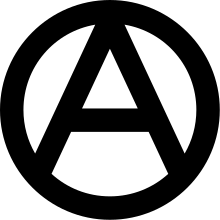Anarchism in Serbia
Anarchism is a political theory that is anti-authoritarian. It focuses on the rejection of government, state, and societal control, especially through rulers or higher authorities.[1] Anarchist ideas and movements have existed in Serbia for many years, and have acted as catalysts for much of the political and social turmoil that has embroiled the country. Throughout every period of political rule, from the control of the Ottoman Empire to the first monarchs of Serbia, Karadjordje and Milan Obrenovic, through the occupation by the Axis powers during World War II,[2] the government has faced opposition and resistance from the public. This opposition has often come from key figures and anarchist groups that have fought against governments and any form of higher authority. Anarchist groups such as the Anarcho-Syndicalists, and movements including Otpor! have contributed to the resistance against the government.[3][4] The anarchist movement continues in Serbia today against the current President Aleksandar Vučić and his government, with protests being held every week against their authority.[5]
History
Throughout the years, the territory now known as Serbia underwent many changes to its geographic boundaries, forms of government, and sources of authoritative power.[6] After centuries of rule from the Ottoman Empire came the First Serbian uprising led by George Petrović, better known as Black George (Karađorđe), who was elected to lead the rebellion and later became the first monarch of the briefly independent Revolutionary Serbia.[7][8]
The 1880s - Milan Obrenovic
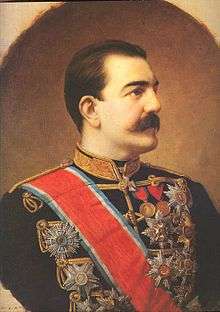
Milan Obrenović, having been Prince of Serbia since 1868, assumed the title of King of Serbia in 1882 and remained in power until 1889.[9] His rule over the newly founded Kingdom of Serbia was met with much opposition, as his close relations with leaders in the Austrian Empire were considered to be unfavourable.[10] Milan Obrenović sided with the Serbian Progressive Party that held the government and proclaimed reforms based on Western principles.[11] Opposing him was the People's Radical Party, which argued for greater democracy and civil freedoms, as well as decentralising local governance.[11] Obrenović and the progressives viewed the radicals as anarchists that threatened law and order, although they took more inspiration from the French Revolution than any anarchist movement.[11] The People's Radical Party held that Obrenović and the progressives were abusing the power of the state, and the movement evolved from a political party into an active movement in July 1882, shortly after Obrenović was proclaimed King.[11]
In 1883, the Timok Rebellion (Serbo-Croatian: Timočka buna) occurred when Milan Obrenović ordered the peasants of the country to hand over their firearms; they refused, backed by the People's Radical Party. Additionally, Obrenović refused to hand over the government to the People's Radical Party, who had won the majority of the votes in the election of September 7.[11] Instead, he appointed Nikola Hristić to become the head of the government.[11] The struggle between the king and the radicals intensified, with the radicals supposedly planning to assassinate the king.[11] A radical uprising was believed to be a possibility by the government.
Tensions between the peasants in eastern Serbia and the government reached their peak when the Progressivist Parliament enacted new laws relating to the establishment of a modern military, as opposed to the popular army that had existed previously.[11] Obrenović declared that the peasants of Serbia must hand over their arms to the military, and condemned the People's Radical Party for their publication of their article Disarmament of the people's army which condemned the government for its friendliness with Austria-Hungary, a state distrusted by many in Serbia. The government argued that the radicals had encouraged the rebellion. When the peasants refused to hand over their weaponry without modern replacements (which would have continued the popular army, and was refused by the government) a brief conflict began, ending when the military crushed the rebels. Some radical leaders, including Pašić, fled to Bulgaria, but many were captured and sentenced to death.
Early 20th Century
In the early twentieth century, the monarchy was still at the head of the Kingdom of Serbia, with the grandson of George (Đorđe) Petrović, King Peter I of Serbia, set to ascend to the throne.[2] Petrović brought democracy to the forefront of leadership in Serbia.[2] The disdain in Serbia for the Ottoman Empire and Austro-Hungarian rule led to the Balkan Wars of 1912-1913 that were fought by the Balkan League against the Ottoman Empire.[12]
Post First World War
In 1918, representatives of three southern Slavic peoples mutually consented and claimed the territory of Serbia as part of the Kingdom of the Serbs, Croats and Slovenes. The former monarch, King Peter I, stepped aside for his son, Crown Prince Alexander, who became King Alexander I of Serbia in 1921.[2] Mounting political tensions in the 1920s resulted in many changes in government ministers, increasing internal rivalries between the Serbs and the Croats,[2] as well as the murders of several Croatian deputies that formed part of the government of the Kingdom of Serbs, Croats and Slovenes.[13] The murders resulted in the withdrawal of the Croatians from Skupština (parliament) and meant that King Alexander I could not form an effective government.[13] As a result, Alexander I imposed a royal dictatorship in 1929.[2] In another attempt to unify the people of his kingdom, Alexander I renamed the territory to the Kingdom of Yugoslavia.[13] He also instated new reforms that included outlawing all political parties based on ethnicity, religious, or geographic divisions.[13] In 1932, the increasing political dissatisfaction with his rule led to his assassination in France.[2] The assassin was identified as Vlado Chernozemski, who was part of the Internal Macedonian Revolutionary Organization.[13] This group was also helped by the Macedonian and Croatian separatist group Ustaša.[13] The monarchy was then passed down to Alexander's son, eleven years old at the time, who later became King Peter II.[2]
Rise of Communism and the Abolition of the Monarchy
Before the beginning of WWII, all of the countries surrounding Yugoslavia were under Nazi control.[2] In April 1941, Yugoslavia was invaded by Germany and its allies (including Bulgaria, Hungary, and Italy), forcing the surrender of the government.[2] The government, along with King Peter II, was exiled to London.[2] The Axis powers in control of Yugoslavia divided it into an array of puppet states, including the regime of Milan Nedić that was established under German control in August 1941.[14] Many Serbs placed their hope in resistance movements after the fall of the Royal Yugoslav Army.[14]
Chetniks (Četnik)
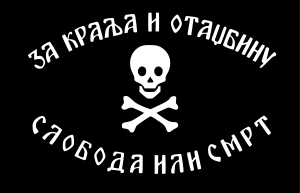
The Chetniks — irregular armed forces led by a former colonel of the Royal Yugoslav Army, Dragoljub (Draža) Mihailovic — were established to resist the Axis invaders.[2] The Chetnik strategy was to create forces out of the disbanded former Yugoslav Army that would assist allied forces when they arrived in Yugoslavia and defeat the Axis occupation in the territory.[15] The rise of the Yugoslav Communist Party and their calls for people's resistance posed an unexpected challenge for the Chetniks.[15] The Chetniks were faced with communist uprisings and feared the loss of lives as well as the potential for a communist revolution.[15] Chetnik nationalism became anti-communist and radicalized, along with harbouring anti-Croat and anti-Muslim attitudes.[15] The increasing tensions in the territory between the ethnic and religious divisions led the Chetniks to believe that the Croatians and Bosnian Muslims were responsible for the political genocide that Serbians where experiencing.[15] Accordingly, Chetnik leaders devised strategies to create ethnically pure Serbian territories in the surrounding states.[15] Thousands of Muslim civilians were killed, communist sympathizers were targeted, and towns were burnt to the ground.[15] They also began to cooperate with German forces to flush out the communists.[16]
Communist Partisans
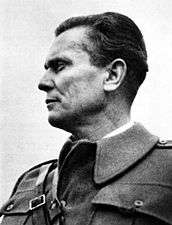
The communist partisans were a part of the larger resistance movement against the Axis occupation of Yugoslavia.[17] The leader of the group, Josip Broz Tito, led small-scale sabotage against the Axis powers and claimed the Serbian town of Užice as a free republic.[17] The Axis powers' retaliation against the resistance movement[17] served to attract more recruits to the movement, leading to the establishment of the People's Liberation Army (PLA). Tito led the Anti-Fascist Council for the National Liberation of Yugoslavia and eventually formed a provisional government.[17] The Battle of Sutjeska was an important event for the communist partisans, as it provided them credibility over the Chetniks in the eyes of the Allies.[17] In 1944, the communist partisans took part in the liberation of Belgrade, which resulted in their coming to power and a long run of communist rule in Yugoslavia.[17]
The communist party's ascent to power resulted in the permanent exile of the monarchy.[2] King Peter II never abdicated and remained in exile for the rest of his life.[2] His son, Crown Prince Alexander, returned to Serbia in 2000, though he has not been reinstated as the monarch.[18]
Anarchist Groups
Anarcho-Syndicalists
The Anarcho-Syndicalism Initiative (ASI) is currently one of the more active anarchist groups operating in Serbia. They are known as the Union Confederation Anarcho-Syndicalist Initiative section that forms part of the International Workers Association[4] and they have committees in many Serbian towns and cities, including Kragujevac, Kula, Cervenka, and Vrsac.[3] They spread their ideology through the magazine Direct Action (Direktna Akcija), which is distributed through various channels to workers instead of being sold on newsstands,[4] and in which they publish pieces against the state, authoritarian control, and capitalism.[3] The group is believed to consist of approximately 1,000 anarchists, many of whom are students and workers.[3]
Arrest of Anarcho-Syndicalists
On September 3, 2009, six members of the Anarcho-Syndicalism Initiative (Tadej Kurepa, Ratibor Trivunac, Sanja Dojkić, Ivan Vulović, Nikola Mitrović, and Ivana Savić) were arrested and charged with international terrorism after they were involved in a Molotov attack on the Greek embassy in Belgrade.[4] It has been claimed that this attack was carried out in solidarity with anti-police protestors who received unjust treatment at the hands of Greek police and prosecutors.[4] The charge carried the possibility of 3–15 years imprisonment and the six were imprisoned for a total of five months.[4]
Otpor
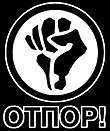
Otpor (the Serbian word for resistance) was best known as a political and civic youth movement that employed non-violent means to resist the alleged corruption and vote-rigging of the Slobodan Milosevic government.[19] By 1996, students had organised demonstrations and protests that were held across the country for four months,[19] yet Otpor met stiff resistance from Milosevic's government leading to a political stalemate.[19] The group used a variety of techniques and events to subvert the authority of the government and to spread its message, including protest, satire, parody, and black humour,[19] and the movement established student networks in major cities across the country.[19] The government's unwillingness to acknowledge the 2000 election results in Serbia resulted in an increasing number of protests,[20] and the activity of Otpor culminated on October 5, 2000, with the overthrow of the Milošević's regime.
Anarchism today

Serbia's most recently elected president, Aleksandar Vucic, and his party, the Serbian Progressive Party (SNS), have faced controversy and protests over alleged censorship and manipulation of the media.[21] There have also been claims of corruption and the forceful silencing of members of the opposition.[22] The catalyst for the current protests started with the attack on the opposition politician and leader of the Alliance of Serbia, Borko Stefanovic.[23] The Alliance of Serbia is a group of 30 opposition parties and organisations that claim that the current government is corrupt.[23] Stefanovic was attacked and struck on the head by unknown assailants on November 23, 2018, in Krusevac.[5] The first protest was held on December 8, 2018, in Belgrade, and thousands of people attended both the first and numerous later protests to demand freedom of the press and free elections, with some protesters saying that they are upset by the limited coverage that the rallies have received in the media.[5]
References
- McLaughlin, Paul (2016-04-15). Anarchism and Authority. doi:10.4324/9781315566948. ISBN 9781315566948.
- "History of the Dynasty". Royal Family of Serbia. Retrieved 2019-06-07.
- BBC (2009). "Belgrade daily examines leading anarchist groups in Serbia". BBC Monitoring European.
- "The Belgrade Six - Serbian Anarchists Arrested for 'International Terrorism'". libcom.org. Retrieved 2019-05-24.
- Reuters (2019-03-17). "Thousands Protest in Serbia to Demand Free Press and Elections". The New York Times. ISSN 0362-4331. Retrieved 2019-05-24.
- Ćirković, Sima M. (2004). The Serbs. Tošić, Vuk. Malden, MA: Blackwell Pub. ISBN 0631204717. OCLC 53232011.
- Fine, John (1994). The Late Medieval Balkans. Ann Arbor, MI: University of Michigan Press. doi:10.3998/mpub.7807. ISBN 9780472082605.
- "Djordje Petrovic, known as Karadjordje". Royal Family of Serbia. Retrieved 2019-06-11.
- Armour, Ian D. (2012). "The Sensitivities of Small, Backward Nations AustriaHungary Serbia and the Regulation of the Danube 1870-71". Canadian Journal of History. 47 (3): 515–544. doi:10.3138/cjh.47.3.515. ISSN 0008-4107.
- "Milan IV (or II) | king of Serbia". Encyclopedia Britannica. Retrieved 2019-05-24.
- Djordjević, Dimitije (1979). "The 1883 peasant uprising in Serbia". Balkan Studies. 20 (2): 235–255.
- "Balkan Wars | European history". Encyclopedia Britannica. Retrieved 2019-06-07.
- "Alexander I | king of Yugoslavia". Encyclopedia Britannica. Retrieved 2019-06-07.
- "Serbia - Government and society". Encyclopedia Britannica. Retrieved 2019-06-07.
- SindbÆk, Tea (April 2009). "The Fall and Rise of a National Hero: Interpretations of Draža Mihailović and the Chetniks in Yugoslavia and Serbia since 1945". Journal of Contemporary European Studies. 17 (1): 47–59. doi:10.1080/14782800902844693. ISSN 1478-2804.
- Trifković, Gaj (2015-07-03). "The Key to the Balkans: The Battle for Serbia 1944". The Journal of Slavic Military Studies. 28 (3): 524–555. doi:10.1080/13518046.2015.1061825. ISSN 1351-8046.
- "Partisan | Yugoslavian military force". Encyclopedia Britannica. Retrieved 2019-06-11.
- Rowley, Tom (2013-06-11). "Crown Prince Alexander II: the man who would be king of Serbia". ISSN 0307-1235. Retrieved 2019-06-11.
- Sombatpoonsiri, Janjira. (2015). Humor and Nonviolent Struggle in Serbia. Syracuse University Press. ISBN 978-0815634072. OCLC 994456566.
- Thompson, Mark R.; Kuntz, Philipp (2004). "Stolen Elections: The Case of the Serbian October". Journal of Democracy. 15 (4): 159–172. doi:10.1353/jod.2004.0074. ISSN 1086-3214.
- "Thousands march in Belgrade in anti-government protest". Reuters. 2019-01-16. Retrieved 2019-06-11.
- "Serbian Protesters Face Dilemma Over Movement's Goals". Balkan Insight. 2019-01-04. Retrieved 2019-06-11.
- "Thousands rally in Belgrade against Serbian president". Reuters. 2019-01-05. Retrieved 2019-05-24.
